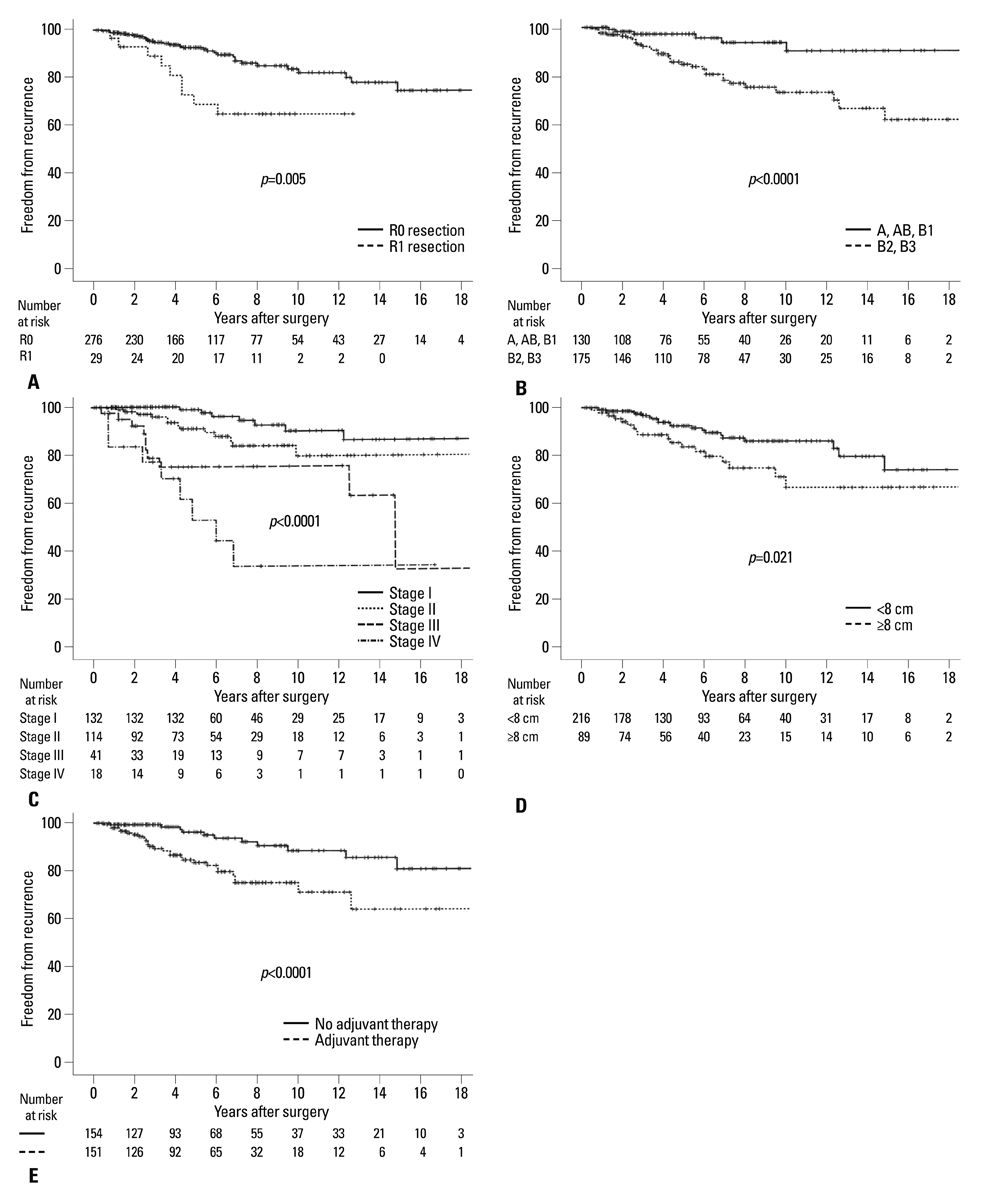Yonsei Med J.
2013 Jul;54(4):875-882. 10.3349/ymj.2013.54.4.875.
Predictors of Recurrence after Thymoma Resection
- Affiliations
-
- 1Department of Thoracic and Cardiovascular Surgery, Yonsei University College of Medicine, Seoul, Korea. kychu@yuhs.ac
- 2Department of Thoracic and Cardiovascular Surgery, Seoul National University Hospital, Seoul National University College of Medicine, Seoul, Korea.
- 3Department of Pathology, Yonsei University College of Medicine, Seoul, Korea.
- KMID: 2158220
- DOI: http://doi.org/10.3349/ymj.2013.54.4.875
Abstract
- PURPOSE
Recurrence rate is considered a better measure of clinical outcomes after thymoma resection than overall survival due to the indolent behavior of thymomas. This study was designed to determine predictors of recurrence after thymoma resection.
MATERIALS AND METHODS
A single-institution, retrospective study was performed, including 305 patients who had undergone thymoma resection between 1986 and 2009.
RESULTS
Among 305 patients, recurrence was observed in 41 patients (13.4%). The recurrence rates were 0% (0/19), 6.3% (4/63), 4.2% (2/48), 18.6% (11/59) and 20.7% (24/116) for type A, AB, B1, B2 and B3 tumors, respectively. The recurrence rate according to Masaoka stage was 6.1% (8/132), 11.4% (13/114), 26.8% (11/41) and 50.0% (9/18) for stages I, II, III and IV, respectively. After univariate analysis, completeness of resection (R0 versus R1), World Health Organization (WHO) histologic type (A, AB, B1 versus B2, B3), Masaoka stage, and size of tumor (<8 cm versus > or =8 cm) demonstrated significant differences with freedom from recurrence. Upon multivariate analysis, Masaoka stage was the only independent predictor of recurrence.
CONCLUSION
WHO histologic type, Masaoka stage, and size of tumor were associated with recurrence. Particularly, Masaoka stage was the only independent predictor of recurrence after thymoma resection.
MeSH Terms
Figure
Reference
-
1. Detterbeck FC. Evaluation and treatment of stage I and II thymoma. J Thorac Oncol. 2010; 5:10 Suppl 4. S318–S322.
Article2. Huang J, Detterbeck FC, Wang Z, Loehrer PJ Sr. Standard outcome measures for thymic malignancies. J Thorac Oncol. 2010; 5:2017–2023.
Article3. Okumura M, Ohta M, Tateyama H, Nakagawa K, Matsumura A, Maeda H, et al. The World Health Organization histologic classification system reflects the oncologic behavior of thymoma: a clinical study of 273 patients. Cancer. 2002; 94:624–632.
Article4. Rea F, Marulli G, Girardi R, Bortolotti L, Favaretto A, Galligioni A, et al. Long-term survival and prognostic factors in thymic epithelial tumours. Eur J Cardiothorac Surg. 2004; 26:412–418.
Article5. Blumberg D, Port JL, Weksler B, Delgado R, Rosai J, Bains MS, et al. Thymoma: a multivariate analysis of factors predicting survival. Ann Thorac Surg. 1995; 60:908–913.
Article6. Regnard JF, Magdeleinat P, Dromer C, Dulmet E, de Montpreville V, Levi JF, et al. Prognostic factors and long-term results after thymoma resection: a series of 307 patients. J Thorac Cardiovasc Surg. 1996; 112:376–384.
Article7. Rosai J, Sobin LH. Histological typing of tumours of the thymus. WHO International histological classification of tumours. 1999. 2nd ed. New York: Springer Verlag.8. Masaoka A, Monden Y, Nakahara K, Tanioka T. Follow-up study of thymomas with special reference to their clinical stages. Cancer. 1981; 48:2485–2492.
Article9. Wright CD, Wain JC, Wong DR, Donahue DM, Gaissert HA, Grillo HC, et al. Predictors of recurrence in thymic tumors: importance of invasion, World Health Organization histology, and size. J Thorac Cardiovasc Surg. 2005; 130:1413–1421.
Article10. Kim DJ, Yang WI, Choi SS, Kim KD, Chung KY. Prognostic and clinical relevance of the World Health Organization schema for the classification of thymic epithelial tumors: a clinicopathologic study of 108 patients and literature review. Chest. 2005; 127:755–761.
Article11. Ströbel P, Bauer A, Puppe B, Kraushaar T, Krein A, Toyka K, et al. Tumor recurrence and survival in patients treated for thymomas and thymic squamous cell carcinomas: a retrospective analysis. J Clin Oncol. 2004; 22:1501–1509.
Article12. Wright CD. Management of thymomas. Crit Rev Oncol Hematol. 2008; 65:109–120.
Article13. Margaritora S, Cesario A, Cusumano G, Meacci E, D'Angelillo R, Bonassi S, et al. Thirty-five-year follow-up analysis of clinical and pathologic outcomes of thymoma surgery. Ann Thorac Surg. 2010; 89:245–252.
Article14. Myojin M, Choi NC, Wright CD, Wain JC, Harris N, Hug EB, et al. Stage III thymoma: pattern of failure after surgery and postoperative radiotherapy and its implication for future study. Int J Radiat Oncol Biol Phys. 2000; 46:927–933.
Article
- Full Text Links
- Actions
-
Cited
- CITED
-
- Close
- Share
- Similar articles
-
- A Case of Spontaneous Remission Organizing Pneumonia after Resection of Thymoma
- Myasthenia Gravis with Thymoma Recurrence 20 Years after Thymectomy: What Is the Optimal Follow-up Duration?
- Temporal Association between Thymoma Recurrence and Exacerbation of Myasthenia Gravis
- Surgical Treatment of Thymoma
- Minimal Change Nephrotic Syndrome Developed after Thymectomy in a Patient with Thymoma



